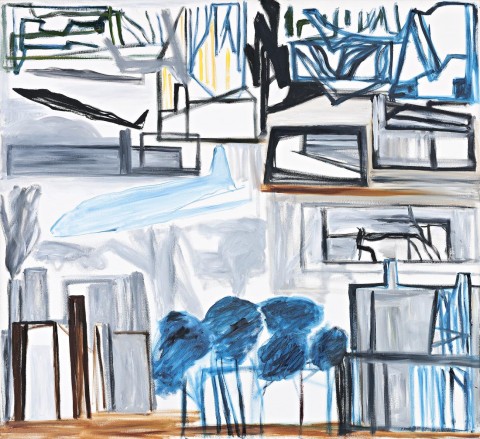SUBURBAN LIGHT NO. 3, 1995
KEN WHISSON
oil on canvas
110.0 x 119.5 cm
signed, dated and inscribed with title verso: Ken Whisson / Perugia 2/1/95 / + 16/4/95 / Title: ‘buildings and smoke ‘ / or: “Suburban Light 3”
Watters Gallery, Sydney (label attached)
Private collection, Sydney
Ken Whisson: An Exhibition of Paintings, Watters Gallery, Sydney, 18 October – 4 November 1995, cat. 6 (illus. in exhibition catalogue)
Ken Whisson has been exhibiting annually in Australia for decades. The consistency of his output over these exhibitions is unmatched and his often-perplexing images are simply unique in Australian art. His 2012 retrospective exhibition at Sydney’s Museum of Contemporary Art and the Heide Museum of Modern Art in Victoria was testament to the high regard in which he is held.
It is possible to view these works as musical scores, or operatic narratives, where the artist uses his brush as a conductor uses a baton. The marks on the surface become a tangible record of emotional interpretation when Whisson replaces the score with his own imaginings. The very moment where the artist’s brush meets the canvas is the point where ideas crystallise, as the artist himself explains: ‘More directly in relation to where art comes from I have a distinct impression when working that the painting takes place at the point where the brush touches the canvas, and I believe that art is a result of a direct line of communication between the act of creation and a level of our being which is neither the conscious nor the famous sub-conscious, but which could be called the intuitive faculty, and which has to function without interference from the conscious thinking process’.1 Indeed, it is Whisson’s highly tuned deftness of touch which is central to his practice and gives his work its distinctive drawn quality. Suburban Light No. 3, 1995, is typical of Whisson’s work from the mid-1990s and was created in his usual manner of reworking the image over numerous painting sessions, often spanning several months.
The various titles, dates and inscriptions on the reverse of the painting attest to this fluid process as each pictorial development intuitively dictates the next. Perhaps surprisingly, given the time he takes, each work remains a fresh, upbeat investigation into the margins between real recollections and imagined worlds. The resulting pictures are just as likely to be memories of a conversation about a place or event, as much as they may be visual depictions of the same.
Typically, recognisable features of Suburban Light No. 3 are the aeroplanes, trees and abstract organic forms which make up the composition. A black cat makes a cameo appearance on a windowsill. These are all part of the artist’s personal repertoire of images which combine to create Whisson’s world. Slabs of paint are spread evenly across the surface, appearing as walls or curtains and interrupting passages of paint as they come dangerously close to creating conventional perspective. Perhaps a notable feature of this painting is the restrained palette the artist deploys. Other works exhibited with the current example refer to the Victorian landscape in their titles, therefore we can assume a connection. The muted browns and greys combine to evoke a bright, dry suburban summer.
There is a profound clarity about Whisson’s paintings and apart from early examples where the influence of Danila Vassilieff and Sidney Nolan is evident, they are totally original. The artist used his early influences as a springboard into his imagination, applied his own ideas about painting and never looked back. His works are direct, uncompromising and unmistakably Whisson in every way.
1. The artist cited in Ken Whisson Paintings 1947 – 1999, Niagara Publishing, Melbourne, 1985, p. 143
HENRY MULHOLLAND
